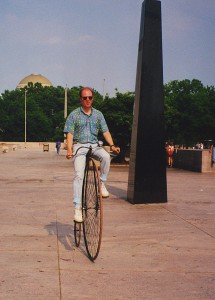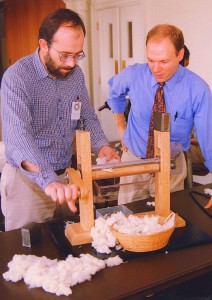A public historian tells all
21 April 2014 – Tim Grove
Well, not quite all. Let me elaborate.
How many times has someone told you that you have the coolest job? I’ve heard this comment at various points in my career, and admittedly, I have had the opportunity to work on some really fun history projects. One in particular—the National Lewis and Clark Bicentennial Exhibition—was truly one of the best. My friends kept telling me to write about these experiences. The time I received a grizzly bear in the mail. My trip on the Lewis and Clark trail with teachers from reservation schools. The meeting of tribal advisors. I decided that if I didn’t record the stories, I would soon forget them. So I began to write. As I wrote about my Lewis and Clark experiences, I thought of earlier projects that molded my thinking about history. I kept writing. I wrote whenever I felt inspired, in the evenings and on weekends. Ultimately a book idea formed, and I ended up with eighteen eclectic chapters about history projects from throughout my career. Because I have worked at some rather high-profile institutions that a wide audience would recognize, I began to think that just maybe someone would be willing to pay to read my stories.
I decided to try to find an agent. After forty queries, I received a request for the full proposal and sample chapters. My new agent thought I made history accessible and liked my chapter about riding a highwheel bicycle. He began sending proposals to top trade publishers, and while they liked my writing, they wanted the book to fit neatly into a genre. It doesn’t; it’s part scholarship, memoir, and insider perspective. After a year with no success, my agent and I parted ways, though he still believed in the book. I decided that a university press might be more willing to think outside the box. My first choice— University of Nebraska Press—accepted the project. The manuscript went through the typical peer review process, and then I signed a contract.
A Grizzly in the Mail and Other Adventures in American History is hot off the presses. It’s a popular history about the life of a public historian. I had several goals in writing the book. Besides wanting to record my stories, I wanted to make the process of history accessible to a wide audience, not only history geeks, but also those who claim to hate history. I chose projects that demonstrate that the pursuit of history is fun, an adventure. It’s a small step toward helping to change the perception in some circles that “history is boring.” I’ve taken a very hands-on approach to history – rode a highwheel bicycle, built a cotton gin, planted and picked cotton on the National Mall, flew over part of the transcontinental airmail route, and hiked, rafted, canoed, and rode horseback on the Lewis and Clark trail.
While the book recounts my adventures and portrays the fun of historical research, it also shows the complexity of history and raises questions that public historians ask: who owns history? Who has the right tell whose story? What primary sources are valid? Why do interpretations change over time? I wanted to show that history is full of gray areas, so I addressed a few popular misconceptions about several people, including Betsy Ross, Sacagawea, and Eli Whitney (no, he did not invent THE cotton gin, he invented A cotton gin).
It’s vitally important that people understand the process of historical research. Rather than feed them our conclusions, sometimes we need to give them the evidence and let them conduct their own analysis. They need to understand the questions we ask and the critical thinking we undertake. I want to encourage my fellow public historians to share their stories. We all have worked on fascinating projects and have gained new perspectives on the past. Yes, we can write for our peers, and scholarship is vital to keep the field strong, but we need to be interacting even more with the public and lifting the veil on our process. Writing popular history books about our adventures in the field is one way to do that.
Check out the book website at: http://grizzlyinthemail.com
~ Tim Grove is Chief of Museum Learning at the Smithsonian National Air and Space Museum by day and author of A Grizzly in the Mail and Other Adventures in American History at all other times.






If you are going for most excellent contents like me,
just pay a visit this web page every day as it provides feature contents, thanks
my webpage; Bing.Com